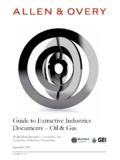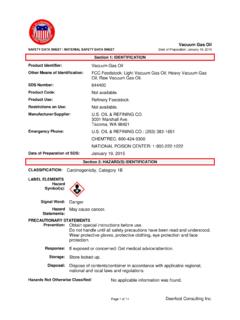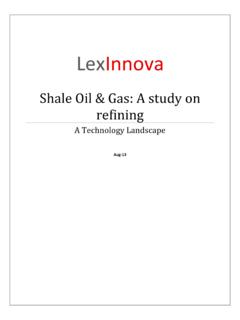Transcription of Oil & Gas Conversion Chart (2008) - Karoon Gas
1 Oil & Gas Conversion Chart (2008) Abbreviations m Thousand mm Million b Billion t Trillion k kilo - 10 M Mega = 10 G Giga = 10 T Tera = 10 P Peta = 10 bbl Barrel bpd Barrels Per Day (Liquids) bopd Barrels of Oil Per Day m bbls Thousand Barrels mm bbls Million Barrels boe Barrel of Oil Equivalent stb Stock Tank Barrel KL Kilolitre scf Standard Cubic Feet mscf Thousand Standard Cubic Feet mmscf Million Standard Cubic Feet (10 ) mmscfd Million Standard Cubic Feet Per Day mRT Metres below the rotary table of the drilling rig bcf Billion Cubic Feet bscf Billion Standard Cubic Feet (10 ) tcf Trillion Cubic Feet scm Standard Cubic Metre Btu British Thermal Unit J Joule Gj Gigajoule 10 TJ Terajoule 10 PJ Petajoule 10 T Tonne Kt Thousand Tonnes Tpa Tonnes Per Annum Toe Tonne of Oil Equivalent Other terms APPEA Australian Petroleum Production & Exploration Association API American Petroleum Institute (oil gravity) AVO Amplitude vs Offset (seismic analysis) BOP Blow out preventer DCQ Daily contract quantity DHI Direct Hydrocarbon Indicator (on seismic)
2 DST Drill Stem Test ESP Electrical submersible pump Feed Front End Engineering and Design FPSO Floating Production, Storage & Offloading Unit GOR Gas oil ratio GWC Gas Water Contact LOGS Wireline logging tool (electronic, sonic, etc) MDQ Minimum Daily Quantity NWSGP North West Shelf Gas Project OOIP Original Oil in Place OWC Oil water contact PRRT Petroleum Resource Rent Tax PSC Production Sharing Contract RFT Repeat Formation Test TVD True Vertical Depth (of hole while drilling) WTI West Texas Intermediate (US benchmark oil) Industry standard boe Barrels of oil equivalent 1 boe 1 Barrel of Oil = Litres 170mm boe = 1 TCF = Imperial gallons/42 US gallons = 6,000 Cubic Feet Gas (Oil Search) = 5,700 Cubic Feet Gas (Woodside) = 5, Cubic Feet Gas (for Santos reserves) = Tonnes LNG = Barrels of Condensate = Tonnes of Condensate = Barrels LPG = Tonnes LPG (Cooper Basin) = Tonnes of LPG (Bass Strait)
3 = Tonnes Propane = Tonnes Butane = Tonnes Coal 1 Kilolitre = Barrels Rates of production/flow 1,000 bpd = 50,000 tonnes per year 100 mmcfd = bcf per year LNG (liquefied natural gas at - 161 degrees Celsius) 1 Tonne LNG = boe (Woodside) = mcf = 1,428 cm = Mbtu (Delivered) 1 Cargo LNG (WPL NWS ships) = 56,000 Tonnes Delivered - (9th ship 62,000) 1 million tonnes of LNG / year = million cubic metres of natural gas per day 1mm scm of Domgas/LNG has a heating equivalent of approximately 6,000 bbls of oil LPG (liquefied petroleum gas [propane & butane]) 1 Tonne LPG = boe (Woodside) 1 Tonne LPG = boe (Santos) Natural gas (primarily methane) assumes heating value of 1000 BTU per cubic foot ITJ = 172 boe = boe (Woodside) = 847 mcf (North West Shelf) = 943 mcf (Cooper Basin) = 948 mcf (Surat Basin) 1 kilojoule = btu 1PJ = 171,937 boe (Santos) 1CF = 1,000 Btu 1 BCF = Pj = mm boe 1 BCF = Petajoules (Santos& Oil Search) 1 BTU = Kj 1 mm Btu = boe (Gulf of Mexico gas) = 1 mcf 1 cubic metres of gas = cubic feet or 35,315 BTU 1 Tonne Ethane = 26,800 cubic feet (Bass Strait) Condensate (from wet gas) 1 Tonne = bbls (Woodside)
4 = bbls 1 BBL Condensate/Naphtha = boe (Santos) = boe (Woodside) Oil & Gas Conversion Chart (2008) SPE reserve definitions Proved (1P) reserves: Quantities of petroleum, which, by analysis of geoscience and engineering data, can be estimated with reasonable certainty to be commercially recoverable, from a given date forward, from known reservoirs under defined economic conditions, operating methods and government regulations. Probabilistic at least 90% probability. Deterministic high degree of confidence. Probable (2P) reserves: Additional reserves which analysis of geoscience and engineering data indicate are less likely to be recovered than proved reserves, but more certain to be recovered than possible reserves.
5 It is equally likely that actual remaining quantities recovered will be greater than or less than the sum of the estimated proved plus probable reserves (2P). Probabilistic at least 50% probability that quantities recovered will equal or exceed the 2P estimate. Possible (3P) reserves: Additional reserves which analysis of geoscience and engineering data suggest are less likely to be recoverable than probable reserves. The total quantities ultimately recovered from a project have a low probability to exceed the sum of provided plus probable plus possible (3P) reserves. Probabilistic at least 10% probability that quantities recovered will equal or exceed the 3P estimate.
6 Probabilistic reserve definitions P90. A probability cut-off of 90% is often used to describe proved reserves. In this case, proved reserves are defined as having a better-than-90% chance of being produced over the life of the field. P50. A probability cut-off of 50% is often used to describe probable reserves. Reserves that have a better-than-50% chance of being technically and economically producible. These are reserves that are often referred to as indicated . P10. A probability cut-off of 10% is often used to describe possible reserves. These are reserves that are often described as inferred.
7 They have a less-than-50% chance of being technically and economically producible. SEC reserve definitions Proved reserves The estimated quantities of crude oil, natural gas and natural gas liquids that geological and engineering data demonstrate with reasonable certainty to be recoverable in future years from known reservoirs under existing economic and operating conditions. Economic producibility must be supported by either actual production or conclusive formation test. The SEC allows 3 Dseismic data to be used in the deep water Gulf of Mexico where high drilling costs prohibit full evaluation of a reservoir section.
8 Contingent reserve definition Quantities of hydrocarbon estimated to be potentially recoverable from known accumulations, but are not currently considered to be commercially recoverable. Contingent resources may be of a significant size, but still have constraints to development. These constraints, preventing the booking of reserves, may relate to lack of gas marketing arrangements or to technical, environmental or political barriers that prevent current economic development. Prospective resources Those quantities of petroleum estimated, as of a given date, to be potentially recoverable from undiscovered accumulations by application of future development projects.
9 This class represents a higher risk than contingent resources as the risk of discovery is also added.




